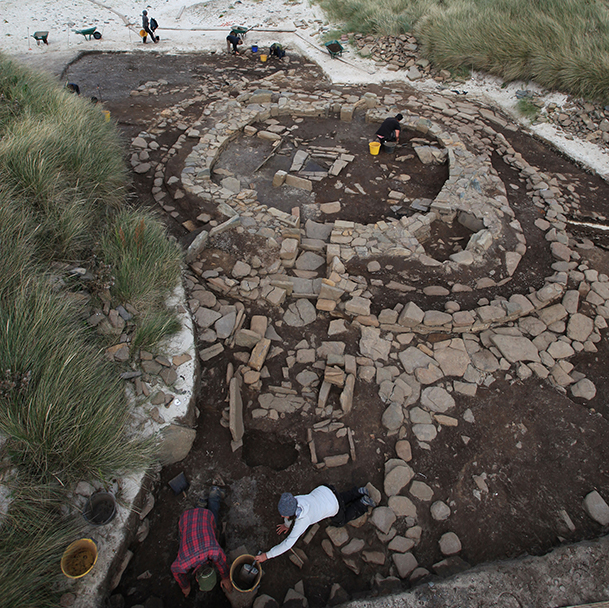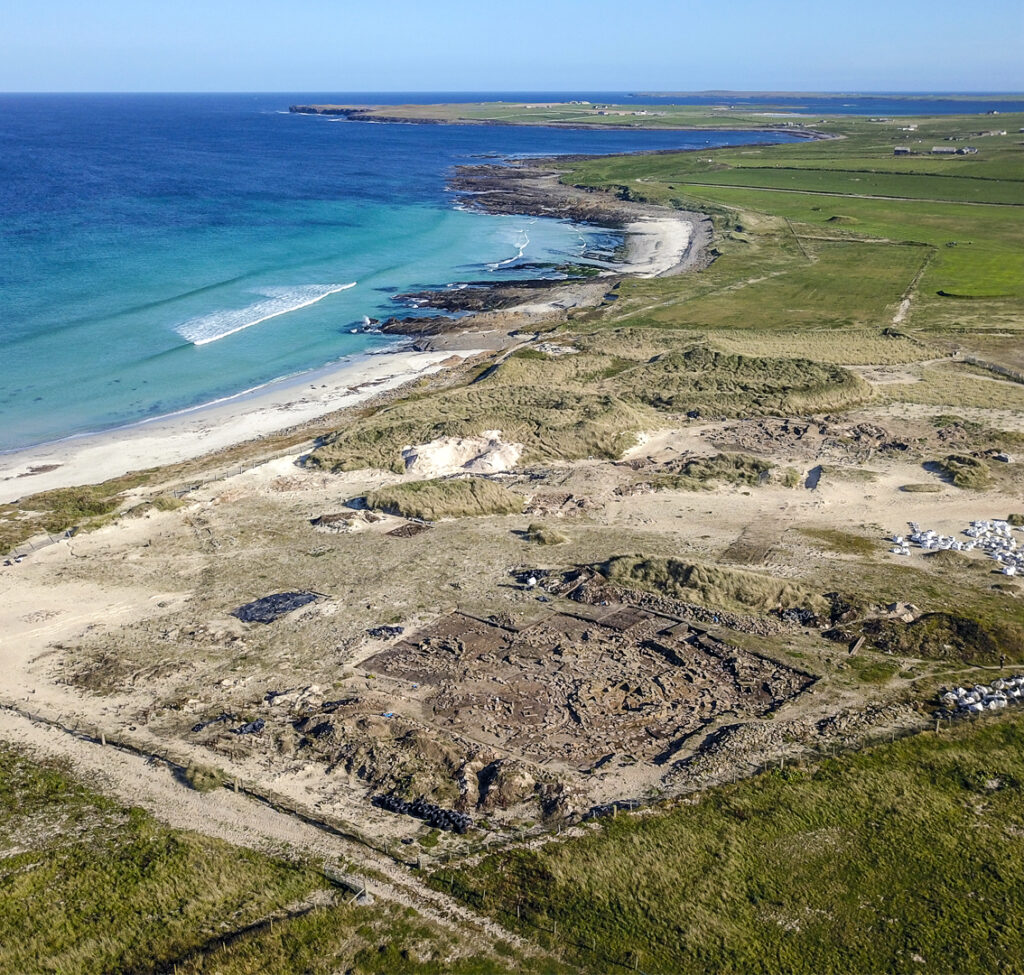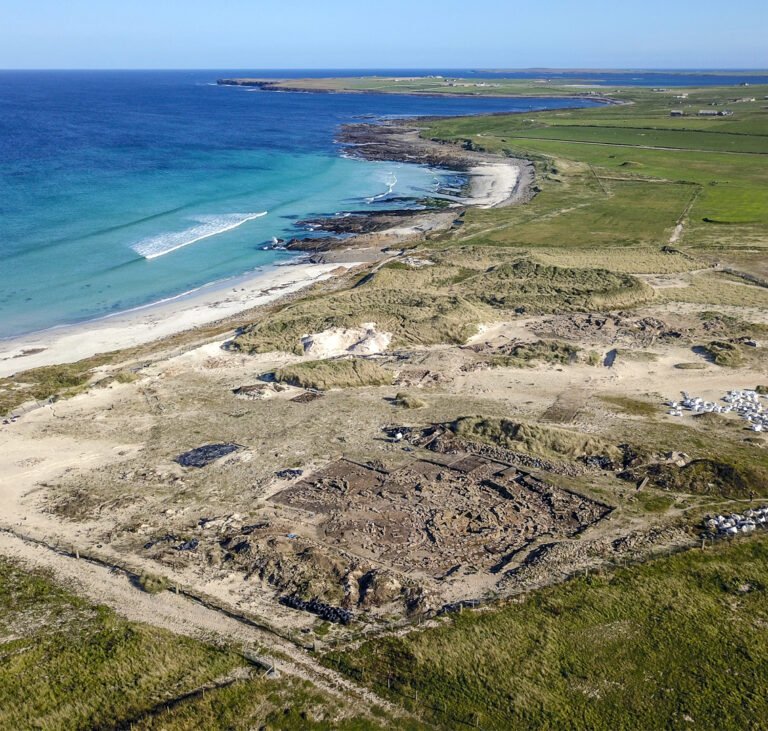Bronze Age women altered genetic landscape of Orkney, study finds
Huddersfield team rewrites the history of prehistoric Orkney with ancient DNA

AN INTERNATIONAL team led by researchers at the University of Huddersfield has used ancient DNA to rewrite the history of the Orkney islands to show that Orkney actually experienced large-scale immigration during the Early Bronze Age, which replaced much of the local population.
The project was a close collaboration between genetic researchers in Huddersfield and Edinburgh, led by Professor Martin Richards and Dr Ceiridwen Edwards, and archaeologists living and working on Orkney.
Orkney – Britain’s Ancient Capital
Orkney is world-famous for its archaeological heritage. Around 5000 years ago, during the Neolithic period when farming first took hold, it was a hugely influential cultural centre. With many superbly preserved stone dwellings, temples and megalithic monuments, and a style of ceramics that appears to have spread out across Britain and Ireland, it has even been described as “Britain’s ancient capital”.
Over the thousand years that followed however, as Europe moved into the Bronze Age, it has been widely viewed that somehow Orkney became left behind. Its influence dwindled and the islands became more insular. But with fewer archaeological remains to study, much less was known about this time.
By combining archaeology with the study of ancient DNA from Bronze Age human remains from the Links of Noltland site, on the remote northern island of Westray, researchers now know much more about this time than ever before, and the results have come as a great surprise to geneticists and archaeologists alike.
“This research shows how much we still have to learn about one of the most momentous events in European prehistory – how the Neolithic came to an end.”
Professor Martin Richards, University of Huddersfield
Firstly, despite the supposed insularity, the team has shown that Orkney experienced large-scale immigration during the Early Bronze Age, which replaced much of the local population. The new arrivals were probably the first to speak Indo-European languages, and carried genetic ancestry derived in part from pastoralists living on the steppe lands north of the Black Sea.
This mirrored what was happening in the rest of Britain and Europe in the third millennium BC. But the researchers found a fascinating difference that makes Orkney highly distinctive.
Across most of Europe, the expansion of pastoralists on the eve of the Bronze Age was typically led by men, with women being sucked into the expanding populations from local farming groups. But in Orkney the researchers found exactly the opposite. The Bronze Age newcomers were mainly women, while male lineages from the original Neolithic population survived for at least another thousand years – something not seen anywhere else. These Neolithic lineages, however, were replaced from the Iron Age and are vanishingly rare today.
Why was Orkney so different?
But why was Orkney so different? Dr Graeme Wilson and Hazel Moore of the Orkney-based EASE Archaeology, who excavated the Links of Noltland, argue that the answer may lie in the long-term stability and self-sufficiency of farmsteads on Orkney, which the genetic data suggests may have already been male dominated by the peak of the Neolithic. When a Europe-wide recession hit towards the end of the Neolithic, they may have been uniquely placed to weather harsher times and maintain their grip on the population as newcomers arrived.
This implies that Orkney was much less insular than has long been assumed, and that there was a protracted period of negotiation between the indigenous males and the newcomers from the south, over many generations.
“This shows that the third-millennium BC expansion across Europe was not a monolithic process but was more complex and varied from place to place,” explained Dr George Foody, one of the lead researchers on the project from the University of Huddersfield.
The results have been surprising for both the archaeologists and geneticists on the team, although for different reasons: the archaeologists did not expect such large-scale immigration, whereas the geneticists did not foresee survival of the Neolithic male lineages.

The University’s Director of the Evolutionary Genomics Research Centre Professor Martin Richards said: “This research shows how much we still have to learn about one of the most momentous events in European prehistory – how the Neolithic came to an end.”
The research has been published by the official journal of the National Academy of Sciences (NAS) and is entitled ‘Ancient DNA at the edge of the world: Continental immigration and the persistence of Neolithic male lineages in Bronze Age Orkney’ by Katharina Dulias, George Foody, Pierre Justeau et al.
The work was part of a Leverhulme Trust Doctoral Scholarship programme awarded to Professor Richards and Dr Maria Pala, and the excavations at the Links of Noltland were funded by Historic Environment Scotland.
Press release from the University of Huddersfield on the wave of immigration dated at the Bronze Age, that altered the genetic landscape of the Orkney islands.
Bronze Age women changed genetic landscape of Orkney, study finds
Orkney experienced a wave of immigration during the Bronze Age so large that it replaced most of the local population, ancient DNA analysis has revealed.
Experts say that unlike anywhere else, the Bronze Age newcomers to the islands were mostly women.
Although male lineages from the original Neolithic population survived for at least another thousand years, by the Iron Age, which followed the Bronze Age, they were largely replaced and are vanishingly rare today.
Researchers from the Universities of Edinburgh and Huddersfield combined archaeology with the study of ancient DNA from Bronze Age human remains to shed light on this pivotal moment for the islands.
New arrivals
Around 5200 years ago, during the Neolithic period, when farming first took hold, Orkney was a hugely influential cultural centre. Yet, as Europe moved into the Bronze Age around 4500 years ago, the islands’ influence dwindled and it supposedly became more insular.
Despite this, after studying human remains from the Links of Noltland site on the remote northern island of Westray, the research team concluded that Orkney experienced large-scale immigration during the Bronze Age.
The new arrivals were probably the first visitors to Orkney speaking Indo-European languages, and carried genetic ancestry derived in part from livestock farmers living on the steppe lands north of the Black Sea.
This migration of people mirrored what was happening in the rest of Great Britain and Europe in the Early to Middle Bronze Age, experts say.
Neolithic males
Across most of Europe, the expansion of livestock farmers on the eve of the Bronze Age was typically led by men.
But in Orkney the researchers found exactly the opposite. The Bronze Age newcomers were mainly women. The survival in Orkney of male lineages from the original Neolithic population for at least another thousand years is not seen anywhere else.
Researchers believe Orkney is so different due to the long-term stability and self-sufficiency of farmsteads on the islands, which the genetic data suggest may have been male dominated by the peak of the Neolithic.
When a Europe-wide recession hit towards the end of the Neolithic, Orkney farmers may have been uniquely placed to weather harsher times and maintain their grip on the population as newcomers arrived.
This implies that Orkney was much less insular than has long been assumed. There was a protracted period of integration of the indigenous males with the newcomers from the south over many generations, experts say.
E
The study, which appears in Proceedings of the National Academy of Sciences (PNAS), was supported by a Leverhulme Trust Doctoral Scholarship programme, Historic Environment Scotland and the Medical Research Council.
Press release from the University of Edinburgh on the wave of immigration dated at the Bronze Age, that altered the genetic landscape of the Orkney islands.
Full Bibliographic Information:
Ancient DNA at the edge of the world: Continental immigration and the persistence of Neolithic male lineages in Bronze Age Orkney
Katharina Dulias, M. George B. Foody, Pierre Justeau, Marina Silva, Rui Martiniano, Gonzalo Oteo-García, Alessandro Fichera, Simão Rodrigues, Francesca Gandini, Alison Meynert, Kevin Donnelly, Timothy J. Aitman, The Scottish Genomes Partnership, Andrew Chamberlain, Olivia Lelong, George Kozikowski, Dominic Powlesland, Clive Waddington, Valeria Mattiangeli, Daniel G. Bradley, Jaroslaw Bryk, Pedro Soares, James F. Wilson, Graeme Wilson, Hazel Moore, Maria Pala, Ceiridwen J. Edwards, Martin B. Richards
Proceedings of the National Academy of Sciences Feb 2022, 119 (8) e2108001119; DOI: 10.1073/pnas.2108001119



